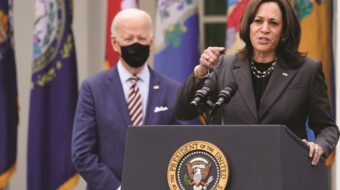
It was 30 years ago this month that Ronald Reagan struck the blow that sent the American labor movement tumbling into a decline it’s still struggling to reverse.
Reagan, one of the most anti-labor presidents in history, set the decline in motion by firing 11,500 of the overworked and underpaid air traffic controllers whose work was essential to the operation of the world’s most complex aviation system.
Reagan fired them because they dared respond to his administration’s refusal to bargain fairly on a new contract by striking in violation of the law prohibiting strikes by federal employees. What’s more, he virtually destroyed their union, the Professional Air Traffic Controllers Organization (PATCO).
Public and private employers everywhere treated Reagan’s 1981 action as a signal to take an uncompromising stand against the unions that they had accepted and bargained with, however reluctantly, as the legitimate representatives of their workers.
At that time, one-fourth of the U.S. workforce was represented by unions. Today, largely because of employer actions since then – often openly illegal actions – the percentage of workers with union bargaining rights is less than half that.
Ironically, PATCO had broken with other AFL-CIO affiliates to endorse Reagan’s successful run for president in 1980. The union did so because Reagan had promised to “take whatever steps are necessary” to improve working conditions and otherwise “bring about a spirit of cooperation between the president and the air traffic controllers.”
Yet PATCO negotiators were rebuffed a year later when they asked for a reduction in working hours, lowering of the retirement age and other steps to ease the controllers’ extraordinary stress, plus a substantial pay raise and updated equipment.
PATCO was faced with either abandoning its demands or striking to try to enforce them. And when the union struck, Reagan, certain of broad public support because of his great popularity, issued an ultimatum to the strikers: Return to work within 48 hours or be fired and replaced permanently by non-union workers.
Faced with millions of dollars in fines for violating Reagan’s order and the anti-strike injunctions that his administration and airlines had sought, and stripped of its right to represent the controllers, PATCO declared bankruptcy and went out of business.
Reagan’s ban on re-hiring strikers was later lifted by Bill Clinton, and three unions, including a revived PATCO, now represent controllers, among them hundreds of those who had been fired. But safety experts say the air traffic control system remains understaffed and the controllers still under far too much stress.
Part of the blame for that rests with Clinton’s successor, George W. Bush, who was as anti-labor as Reagan. The Bush administration, in fact, imposed an onerous new contract on the controllers that cut their pay and pensions.
It’s not likely that other employers will soon abandon the crippling anti-labor practices that were inspired and furthered by Reagan. Hiring and permanently replacing strikers, previously a rare occurrence, has become a relatively common employer tactic. And strikes – an indispensable weapon for workers in collective bargaining – have become relatively rare post-Reagan.
It isn’t just strikers who face penalties for exercising their legal rights. Some employers also have taken to firing or otherwise penalizing workers who seek union recognition, despite the law that promises them the right to freely choose to unionize. Many employers have also hired “management consultants” who specialize in Reagan-style union busting.
It’s no coincidence that, as union ranks have shrunk under the relentless anti-labor pressures first applied to air traffic controllers three decades ago by Ronald Reagan, the ranks of the middle class also have shrunk as has the ordinary American’s share of the country’s wealth.
The situation for air traffic controllers has stayed much the same. They’re still demanding longer rest periods during working hours and between shifts and other improved working conditions that are clearly necessary for their wellbeing and that of those they serve. And they’re still being rebuffed by the Federal Aviation Administration.
Republican leaders in Congress have made it even more difficult for the controllers and many others by insisting that a measure making it more difficult for workers to unionize be attached to the current bill that would continue the FAA’s funding for another year. A congressional stalemate over that was the principal reason for the recent partial shutdown of the FAA, which cost the government millions of dollars in lost airline taxes, threw several thousand airport construction workers and FAA employees out of work, and forced airline safety inspectors to work without pay throughout the two-week stalemate.
Although air traffic controllers and other FAA employees are back on the job, that could be only a temporary respite. The stalemate could very well resume when Congress returns from its current recess on Sept. 16th and again takes up FAA funding.
The attempt by congressional Republicans to weaken FAA employees’ basic union rights – and their willingness to shut down the air traffic system in order to further that goal – is yet another aspect of the legacy of Ronald Reagan, one of the most damaging and successful union-busters of all time.
Photo: Jonathan Thorne // CC 2.0












Comments